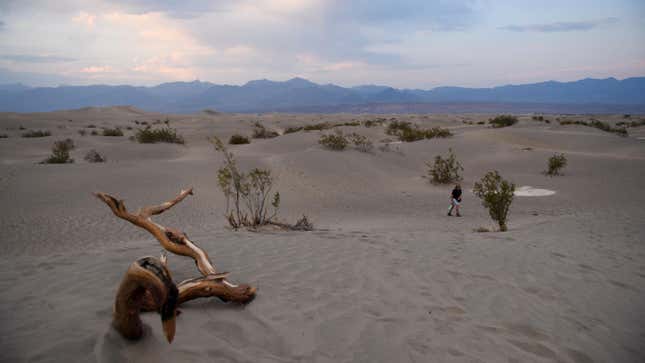
There’s one thing that many Americans can affirm right now: It’s freaking hot. In case you still had any doubts, Death Valley, California—the hottest, driest, and lowest place in the country—experienced a temperature of 130 degrees Fahrenheit (54.4 degrees Celsius) on Friday, one of the hottest temperatures ever reliably recorded on the planet.
The National Weather Service reported the park’s searing hot temperature on Friday, adding that there was a one in four chance of Death Valley reaching 130 degrees Fahrenheit (54.4 degrees Celsius) yet again on both Saturday and Sunday. As of 12 p.m. on Saturday, the agency said that it was already 123 degrees Fahrenheit (50.6 degrees Celsius) in the Death Valley.
“These extreme temps are NO joke! Be mindful before heading outdoors this weekend. Do not put yourself, nor first responders in danger!” the National Weather Service office in Las Vegas said on Twitter on Saturday.
Death Valley’s wild and alarming temperature reading on Friday is tied for the hottest temperature reliably recorded on Earth with, unsurprisingly, its own previous highest temperature from August of last year. At that time, the park also recorded a temperature of 130 degrees Fahrenheit (54.4 degrees Celsius).
Saying Death Valley’s records from 2020 and this year are the highest temperatures ever recorded on Earth is not without debate, though. As explained by the Washington Post, the 130-degree reading is behind only two other temperatures ever measured. The first one is a 134-degree Fahrenheit (56.7 degrees Celsius) reading in Death Valley on July 10, 1913, and the other is a 131-degree (55 degrees Celsius) measurement in Kebili, Tunisia on July 7, 1931.
The Post cites weather historian Christopher Burt, who has criticized the 1913 Death Valley record temperature as “essentially not possible from a meteorological perspective.” Burt has also questioned the 1931 Kebili temperature, stating that the older measurements “involved thermometers and shelters that probably would not be accepted today.”
Nonetheless, the 134-degree Fahrenheit reading is accepted as official by the World Meteorological Organization and the U.S. National Oceanic and Atmospheric Administration.
Whether you believe the 134-degree Fahrenheit measurement was reliably recorded or not, the NWS doesn’t believe Death Valley will break that record this weekend.
Death Valley’s record-high temperature is only one detail of the dangerous and extreme heat affecting our planet. The West Coast is on track to suffer another heat wave this weekend, shortly after the Pacific Northwest experienced a heat wave that has been called a “mass casualty event.” In addition, NOAA has stated that June 2021 was the hottest June on record in the U.S.
Heat waves are just one of the many effects of climate change, and they’re going to get worse. Scientists with World Weather Attribution have said that the heat wave in the Pacific Northwest, though considered rare or extremely rare in today’s climate, “would be virtually impossible without human-caused climate change.”
“As warming continues, it will become a lot less rare,” they wrote.